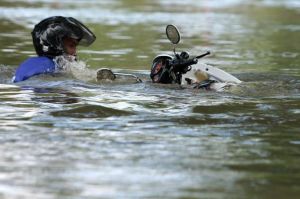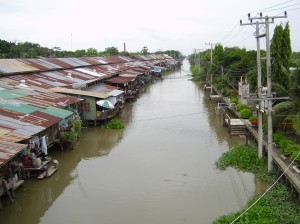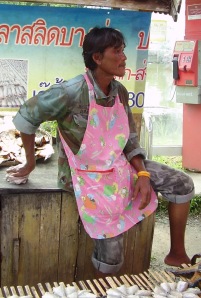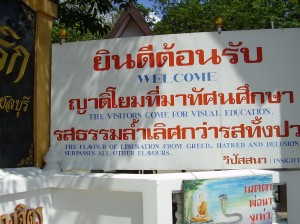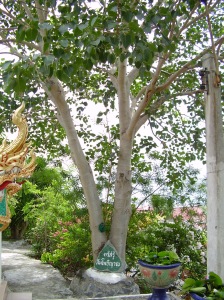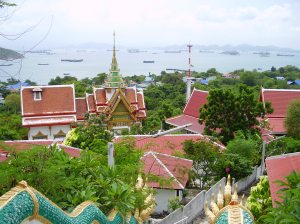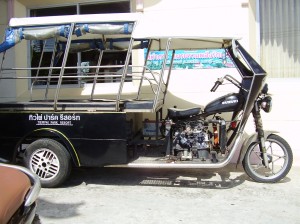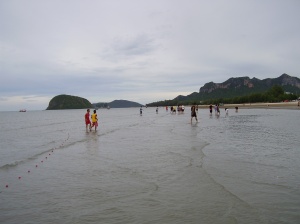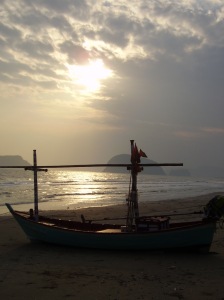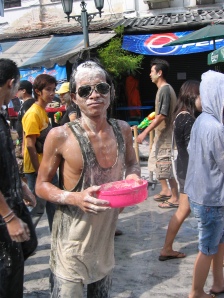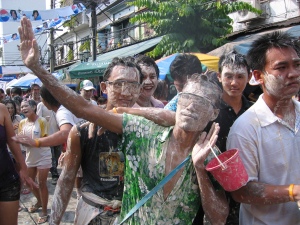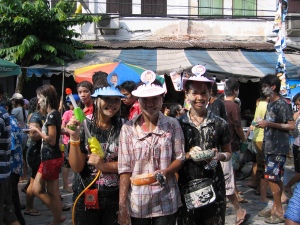I don’t like fire ants. I want to make that abundantly clear. But I do like Google’s satellite images. In the absence of anything resembling a good map here in Thailand, the combination of Google maps and their satellite images is wonderful. I often use that to identify something interesting I have passed by. Recently, I was taking a look at a large area of greenery that I pass on my way to work and spotted something that looked interesting on our side of the river. There, along the east bank of the Chao Praya River in Samut Prakan was what appeared to be a path through the jungle running almost on the edge of the river. Even better, it looked easy to get to.
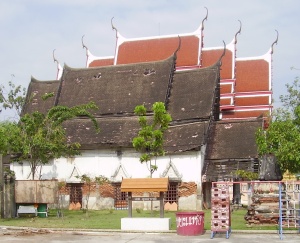
The old ordination hall in front of the new one.
Opposite the Erewan Museum, on old Sukhumvit Road, is a small street called Soi Bang Duan. And, thinking of myself as an ever-intrepid explorer, off I went dragging my wife and a friend with me. We drove all the way to the end of the street where there is a lovely temple supported by the local community. It’s called Wat Bang Duan Nok and I made use of their car park. The original ordination chapel, several hundred years old is still standing but not in the best state of repair. Last year, it was badly flooded and two companies have since helped raise the ground level and the chapel floor but there is no money for urgently needed roof repairs. The hall is protected by a trio of aggressive temple dogs but a very friendly monk did his utmost to assure me that they wouldn’t bite. I waited for my wife and our friend to return from the toilet and sent them in first as a sort of experiment. They didn’t bite and neither did the dogs.

The path seemed to be clear and well maintained.
The path I had seen was very easy to find and exactly where the satellite image showed it! As you go into the temple car park, look to your left where you will see a water gate. Walk across that and there is the path. For a short while it was easy going and well maintained. But not for long! Very soon, we were hacking our way through jungle using the inevitable stick to bang for snakes and other wee beasties we didn’t want around our ankles. We could just about make out the path but it was getting worse and, pushing through the foliage, more and more fire ants were landing on me and attacking. Not the most pleasant sensation so I whimpered loudly as a way of encouraging my companions to get them off me. Eventually, the path all but disappeared and, reluctantly, we decided it was time to turn back.

Eventually the path all but disappeared.
However, I had seen another possibility on Google and, asking the locals, that seemed very likely. So we walked back up the street we had driven down for almost half a kilometre and took the second raised concrete walkway on our right, just before a small shop and with a thing like a memorial to (or housing the spirit of) a dead child on the corner. The people in the shop told us that the path we had originally tried is only passable in the dry season and here we were at the end of the rainy season, trying to get through when it would be at its worst! The walkway provided lovely easy walking with plenty of shade. At a fork in the path, we bore right and were very soon walking through a huge area of nipa palm trees. The Thai name for the nipa palm is ‘jaak’ and it has many uses. The leaf can be used to wrap a local dessert called ‘khanom jaak’, they are stitched together to make roofing material, brooms are made from them, hats, baskets, fish traps and more. The fruit is also edible although I haven’t tried it.

The spirit thingy.
We passed another small community and shortly after that the raised walkway finished, leading us on to the same path we had abandoned earlier. It was in good repair here and we walked eastwards along the river. Mostly it was just out of sight but every now and then we came across a tiny path leading to the water’s edge. Now it was just us, nature and the tankers we could hear on the river! Before long, we reached a large fenced compound blocking the path. This was the Marine Training Centre and we turned right, following a small boardwalk along the edge. At the river bank, this changed to a concrete path leading us around the perimeter of the centre and, eventually a road bridge. We crossed the bridge and followed the road, which was old Sukhumvit Soi 6.

The Chao Praya river was just to our right.
A short distance along on the right is another large compound, this one belonging to the police. We wandered in and, in the far left corner by the riverside is an almost hidden gate. Walking through there, we found ourselves in the kitchen area of a large restaurant which was opportune as we were hungry. We were shown into the restaurant proper and enjoyed the air conditioning. The food wasn’t bad either. After lunch, we retrod our steps back to the car and are now planning to do it again in the dry season when we should be able to make it a circular walk.

Lovely sign in the restaurant we stumbled upon.



